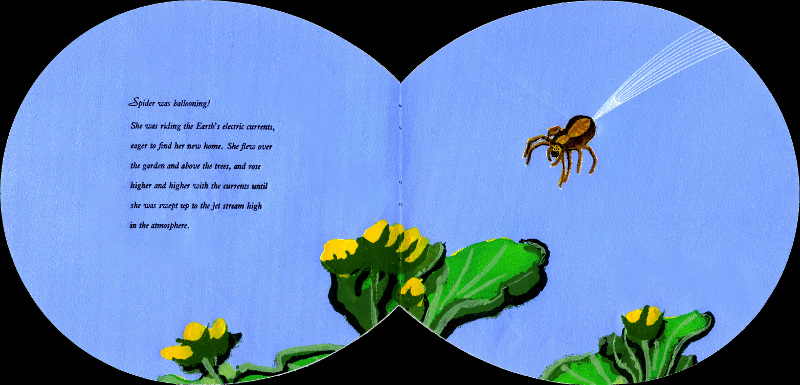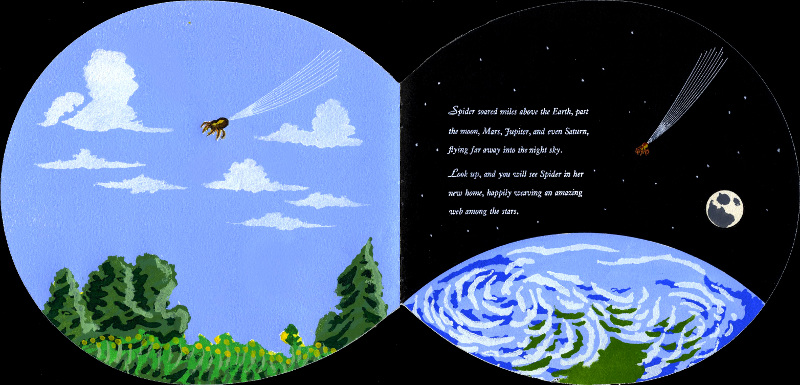CATALOG NO. B113-2023
Spider and the Stars
Spider and the Stars, a Luminice Press artist book by Thomas Parker Williams and Mary Agnes Williams, combines an original illustrated story for young readers with factual information about spiders and the curious way they travel long distances.

Spider and the Stars closed

Spider and the Stars cover open

Spider and the Stars pop up closed

Spider and the Stars pop up fully open
Specifications - Edition of 14
Cover - Laser cut wood; oil-based pochoir printed paper
Pop-up and Carrier - Reduction linocut; cut with scroll saw
16-page movable book/codex, 7.5" x 8" closed; pop-up opens to 19" x 24".
pages cut using laser-cut steel template; Arches book paper
Illustrations - Oil-based pochoir over linocut flood coats;
hand-painted accents
Inks - Oil-based relief inks and dry pigments in burnt plate oil
Text - Hand set in Janson and Janson Italic; letterpress printed
on the Luminice Press.
Thomas Parker Williams Concept, design, illustrations, pop-up, printing, binding
Mary Agnes Williams - Concept, original story, design, handset text, printing
Collections
Permanent collection -
Penn State University
University of MD Special Collections

Spider and the Stars - page 1
300 million years! That's how long
spiders have lived on Earth.
Today there are more
than 45,000 known species and
countless numbers of the
eight-legged creatures.
One day, a special little spider
found her way to the stars!
This is her story.

Spider began making a web with a single strand of silk she released from her abdomen. It dangled from a leaf in the garden, was caught by a breeze, and stuck to another leaf, creating a bridge. Spider crossed it, and made more silk to form the frame, spokes, and center of her web. Switching to sticky silk, she used her legs to weave the rest of the web in concentric circles. She worked quickly but carefully until she reached the core.

Spider silk is composed of proteins that make
it strong as well as flexible. It is extruded from
spinnerets, complex glands located on the
spider's abdomen. Most spiders have six
spinnerets, each with many microscopic
spigots, each producing
a different type of silk.
Spider used fine, structural, and sticky silk to make her web. When it was completed, she waited for her prey. Then it started raining . .

An ordinary rain shower would not stop Spider from weaving
another web. But a serious flood forced her to look for a new
home. Crawling on the ground would take too long, so she
began the fascinating process called ballooning.
Ballooning has intrigued people for centuries. Spiders don't have wings, so how can they travel to the next garden, or another town? Spiders can't fly, yet they've been found on distant mountaintops and in the ocean, far from land.

For a long time it was thought that warm, light breezes
carried spiders aloft. But a study by British scientists in
2018 showed that spiders take advantage of the Earth's
electric field to become airborne.
Finding a tall plant, Spider anchored herself to a sturdy
leaf with a strand of silk, then lifted her two front legs in
the air. With tiny sensory hairs called trichobothria she
detected the Earth's electrostatic forces and, when the
time was right, she started "tiptoeing," standing on the
ends of her legs.
Suddenly,
strands of silk fanned out from her
abdomen and reached for the sky.
She cut the anchor, and then . . .

Spider was ballooning!
She was riding the Earth's electric currents,
eager to find her new home. She flew over
the garden and above the trees, and rose
higher and higher with the currents until
she was swept up to the jet stream high in
the atmosphere.

Spider soared miles above the Earth, past
the moon, Mars, Jupiter, and even Saturn,
flying far away into the night sky.
Look up, and you will see Spider in her
new home, happily weaving an amazing
web among the stars.
